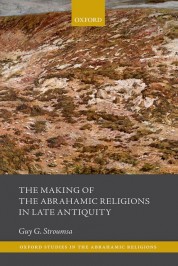The Making of the Abrahamic Religions in Late Antiquity

The Making of the Abrahamic Religions in Late Antiquity
Oxford Studies in the Abrahamic Religions
Guy G. Stroumsa
Oxford University Press 2015
- Launches the new Oxford Studies in the Abrahamic Religions series
- Shows how religious history of late antiquity informs our understanding of the genesis of Islam
- Examines the main developments in religious trends in the Near East (in particular in Christianity) from the first to the seventh century
- Shows how the end of blood sacrifices represented one of the most significant transformations of religion in late antiquity
This book presents how ancient Christianity must be understood from the viewpoint of the history of religions in late antiquity. The continuation of biblical prophecy runs like a thread from Jesus through Mani to Muhammad. And yet this thread, arguably the single most important characteristic of the Abrahamic movement, often remains outside the mainstream, hidden, as it were, since it generates heresy. The figures of the Gnostic, the holy man, and the mystic are all sequels of the Israelite prophet. They reflect a mode of religiosity that is characterized by high intensity. It is centripetal and activist by nature and emphasizes sectarianism and polemics, esoteric knowledge, or gnosis and charisma. The other mode of religiosity, much more common than the first, is centrifugal and irenic. It favours an ecumenical attitude, contents itself with a widely shared faith, or pistis, and reflects, in Weberian parlance, the routinisation of the new religious movement. This is the mode of priests and bishops, rather than that of martyrs and holy men. These two main modes of religion, high versus low intensity, exist simultaneously, and cross the boundaries of religious communities. They offer a tool permitting us to follow the transformations of religion in late antiquity in general, and in ancient Christianity in particular, without becoming prisoners of the traditional categories of patristic literature. Through the dialectical relationship between these two modes of religiosity, one can follow the complex transformations of ancient Christianity in its broad religious context.